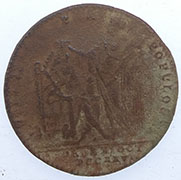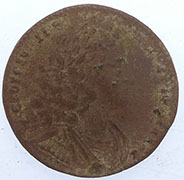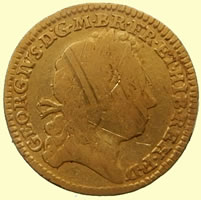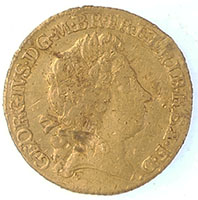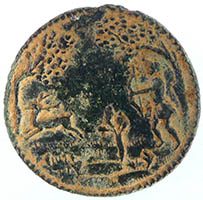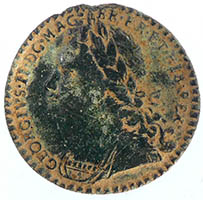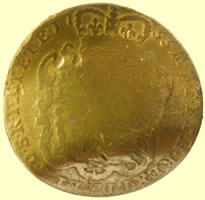

Metal detecting holidays in England with the World's most successful metal detecting club.20 years plus.
Twinned with Midwest Historical Research Society USA.
George 1st -1714-1727
1714 George 1st official coronation medal by John Crocker.
|
|

George was elector of Hanover and, from 1714, the first Hanoverian king of Great Britain. George was born on 28 Mary 1660 in Hanover, Germany, the eldest son of the Duke of Brunswick-Lüneburg. In 1682, George married his cousin Sophia and they had two children. A decade later, he divorced her for alleged infidelity and imprisoned her in a castle until her death in 1726. In 1701, under the Act of Settlement, George's mother Sophia was nominated heiress to the English throne if the reigning monarch William III and his heir Anne died without issue. The Act sought to guarantee a Protestant succession and George's mother was the closest Protestant relative, although there were at least 50 Catholic relatives whose claims were stronger. The Electress Sophia and Anne died in quick succession and George became king in August 1714. The following year George was faced with a rebellion by the Jacobites, supporters of the Catholic James Stuart, who had a strong claim to the throne. This was concentrated mainly in Scotland, and was suppressed by the end of the year. Another smaller rebellion in 1719 was not a serious threat. With some Tories sympathetic to the Jacobites, George turned to the Whigs to form a government, and they were to dominate politics for the next generation. Opposition to the king gathered around George's only son, the prince of Wales, making their already poor relationship even worse. George was active in British foreign policy in the early years of his reign. His shrewd diplomatic judgment enabled him to help forge an anti-Spanish alliance with France in 1717 - 1718. In 1720 the South Sea Company, with heavy government, royal and aristocratic investment, collapsed. The resulting economic crisis made the king and his ministers extremely unpopular. Robert Walpole was left as the most important figure in the administration and in April 1721 was appointed first lord of the Treasury and in effect, 'prime minister'. His ascendancy coincided with the decline of the political power of the monarchy and George became less and less involved in government. George remained unpopular in England throughout his life, partly because of his inability to speak English but also because of the perceived greed of his mistresses and rumours concerning his treatment of his wife. George died on 11 June 1727 during a visit to Hanover and was succeeded by his son.
1719 George 1st milled gold half guinea 3.97g, 21mm
1717 George 1st milled gold half guinea 4.16g, 20.84mm |
|
 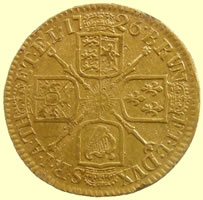 |
 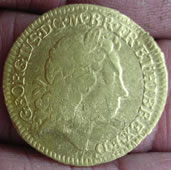 |
| 1726 George 1st milled gold full guinea | 1718 George 1st gold half guinea - 4.14g, 21.35mm |
George 1st shilling (12 pence) |
|
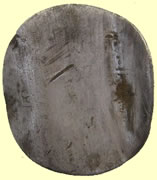 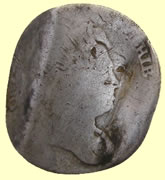 |
  |
| 1714 -1727 - love token | 1718 |
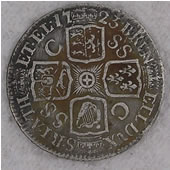 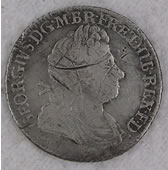 |
  |
| 1723 | 1723 |
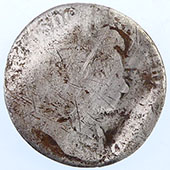  |
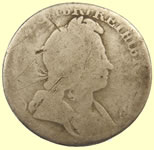  |
| 1714 -1727 | 1723 |
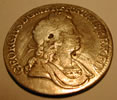 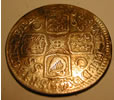 |
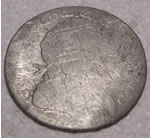 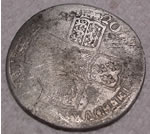 |
| 1723 | 1720 |
  |
|
| 1723 George 1st milled silver shilling | |
George 1st sixpence |
|
  |
 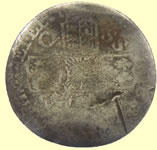 |
| Milled silver sixpence - love token | Milled silver sixpence - love token |
  |
 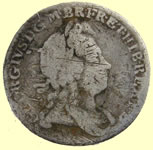 |
| 1720 | 1723 issued by South Sea Company |
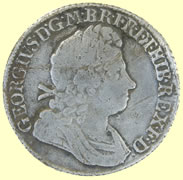 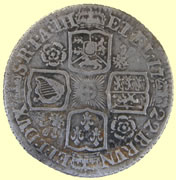 |
 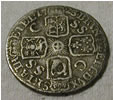 |
| 1722 | 1723 - issued by South Sea Company |
  |
  |
| 1723 -SSC South Seas Company | 1723 |
  |
|
| 1723 | |
George 1st two pence |
|
 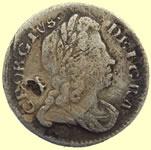 |
  |
| 1721 | 1721 |
George 1st penny12mm, 0.49g |
|
  |
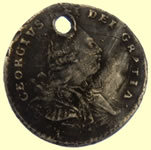  |
| 1720 milled silver penny | 1722 |
 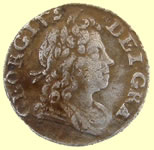 |
  |
| 1727 | 1723
|
  |
|
| 1727 | |
George II 1727-1760
Medal Great Britain George II Indian Peace 1757 Obverse with laureate armored bust left, GEORGIVS II DG MAG BR FR ET HIB REX around. Reverse with Native American hunting scene in forest, deer running with archer's arrow in mid-air. This could be an amazing discovery 'Wow! Search under peace medal. It is one of the earliest made for Indian trade in America.' Dan
|
|

George was elector of Hanover and second Hanoverian king of Great Britain and Ireland. George was born in Hanover, Germany on 10 November 1683, the only son of the elector of Hanover. In 1705 he married Princess Caroline of Brandenburg-Ansbach, and they had nine children. In 1714, George's father succeeded to the British throne, and created George prince of Wales. The relationship between father and son was already poor and the prince's London residence, Leicester House, became a rival court and focus for a dissident Whig group which included Robert Walpole. He encouraged a reconciliation between father and son. This led to Walpole's inclusion in George I's administration, whereupon he lost the prince's favour. Only Caroline's intervention kept Walpole in office when the prince succeeded to the throne in 1727. He cemented his position by securing George a Civil List (allowance) from parliament of £800,000, considerably more than previous monarchs had received. Walpole also won acknowledgement of George's legitimacy from many influential Tories who supported the exiled Stuart pretender to the English throne. As a result, no senior politician deserted George's cause during the Jacobite Rebellion of 1745. Charles Edward Stuart, the 'Young Pretender' landed in Scotland but, after some initial success, was defeated at the Battle of Culloden in 1746. George seemed destined to imitate his father, quarrelling with his son Frederick Louis, Prince of Wales, who in turn became a leader of an anti-administration faction. War broke out with Spain in 1739. In 1742 Walpole, who had dominated government since 1721, resigned. George quickly found another mentor in John Carteret who, with George, brought England into the War of the Austrian Succession (1740-1748), prompting accusations that he was subordinating English interests to those of George's German possessions. In 1743, George led his troops into battle against the French at Dettingen, the last British king to fight in battle. During the last decade of his life George took little interest in politics. Britain's involvement in the Seven Years' War (1756 - 1763) was largely overseen by William Pitt the Elder. This period also saw the expansion of British influence in India and Canada with the military successes of Robert Clive and James Wolfe respectively. George died on 25 October 1760. Frederick had died in 1751, leaving George's grandson to inherit the throne. |
|
 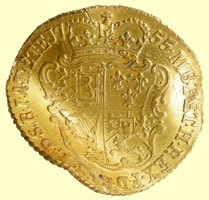 |
  |
| 1755 George II gold half guinea | 1758 George II 1/2 Guinea |
|
|
| 1733 George II milled gold full guinea love token | 1759 George II milled gold guinea 25mm dia, 8.44g |
George II Shilling |
|
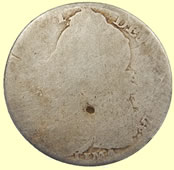  |
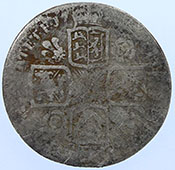  |
| 1727- 1760 | 1727 - 1760 |
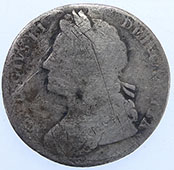 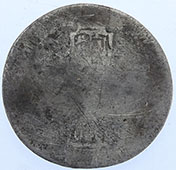 |
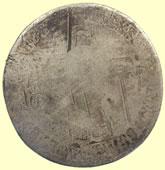 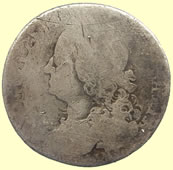 |
| 1727- 60 | 1730 |
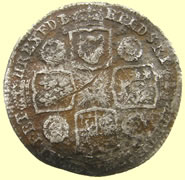  |
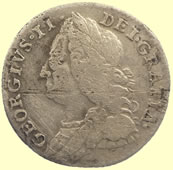  |
| 1727- 60 | 1758 |
  |
  |
| 1758 | 1745 |
  |
  |
| 1731 | 1727-1760 |
George II Six pence |
|
 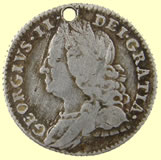 |
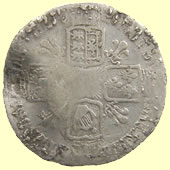 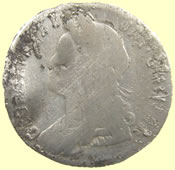 |
| 1757 | 1728 |
 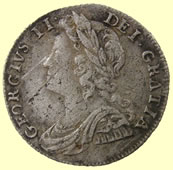 |
  |
| 1739 | 1727 - 1760 |
  |
  |
| 1727 - 1760 | 1757 |
 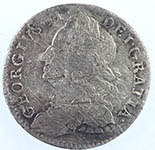 |
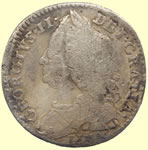  |
| 1757 | 1746 |
  |
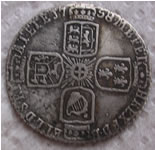 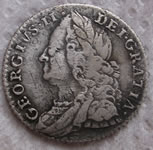 |
| 1739 | 1758 |
  |
  |
| 1757 | 1757 |
George II Three pence |
|
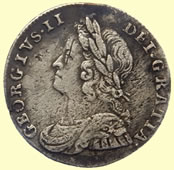  |
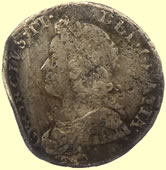  |
| 1729 | 1740 |
George II Two pence |
|
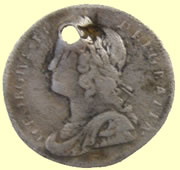  |
|
| 1767 | |
George II One pence0.46g,12.19mm |
|
 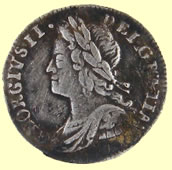 |
  |
| 1732 | 1746 |
 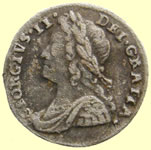 |
 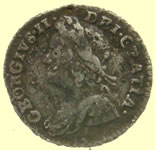 |
| 1737 | 1743 |
  |
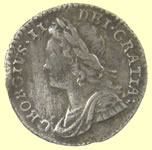 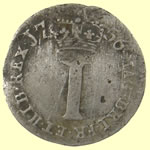 |
| 1732 | 1756 |
 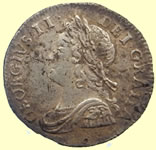 |
 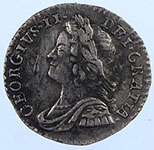 |
| 1731 | 1750 |
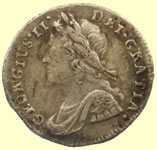 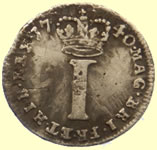 |
  |
| 1740 | 1739 |
  |
  |
| 1750 | 1743 |
  |
  |
| 1740 | 1758 |
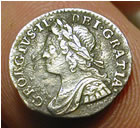  |
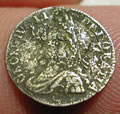 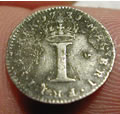 |
| 1753 | 1737 |
  |
 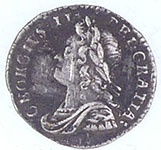 |
| 1743 | 1755 |
  |
|
| 1743 | |
 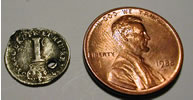 |
|
| 1758 George II silver one pence with size comparison to USA penny | |
George III to V coins on separate page click here
|
|
